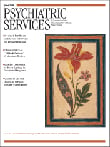Letters
Student Attitudes After a Psychiatric Hospital Tour
To the Editor: In summer 2005 I taught an upper-division university class in abnormal psychology. To link the lectures with the outside world and to put human faces on the DSM disorders, I arranged a field trip to a 1,100-bed state hospital. I also decided to do a before-and-after study of tour participants and to use students in the class who did not go on the tour as a control group.
On the first day of class, before any substantive discussion of subject matter, students were asked to fill out semantic differential scales rating the hospital scheduled for the tour, the hospital's patients, and its architecture. This procedure was done to assess expectations of the students. Seven-point adjective scales were used to rate 36 items; each of the three categories rated (hospital, patients, and architecture) was rated on 12 items. For example, the hospital architecture was rated from active to passive and patients were rated from young to old. This instrument assesses the connotative meaning of objects, places, or concepts. Later in the same class period, students had the opportunity to sign up for an optional field trip to this state hospital. No significant difference was seen in favorability ratings between students who signed up and those who did not.
Ten days after the sign-up, 22 students went on the field trip, accompanied by myself and the teaching assistant. Local arrangements were made by Stephen Veit, Ph.D., and Richard Lesch, Ph.D., of the hospital staff, who also led the ward tours. Three days after the tour (a weekend and an examination intervened), the class made their ratings a second time. A total of 22 students who filled out both questionnaires did not go on the field trip.
Probably because the students were unfamiliar with the hospital, most ratings before the visit clustered around the scale midpoint (4.0). No ratings of patients averaged one scale value above or below the midpoint. Items that deviated one scale value above or below the midpoint were as follows: students expected the hospital to be large, old, orderly, clean, and calm, and they expected the hospital architecture to be old, orderly, clean, and calm.
After students went on the tour, their views changed somewhat; they viewed the hospital as being significantly larger and calmer than they had expected, and they rated the patients as being significantly calmer and more orderly. There were no changes in ratings of hospital architecture.
On the second set of ratings, compared with students who did not go on the tour, those who went on the tour rated the hospital as being significantly larger, slower, quieter, and cleaner (p<.05) and marginally calmer and more orderly (p<.10); they rated the patients as being significantly calmer and more orderly and large (p<.05) (the last probably reflecting large numbers of patients) and rated the architecture as marginally calmer and more beautiful, strong, and orderly (p<.10).
There was no "madhouse image" before or after the tour. Hospital ambiance was perceived as calm, orderly, and clean, with an overall "good" rating both before and after the tour. On the basis of the students' ratings, the tour left students with a positive and realistic image of the hospital and its staff. Subsequent comments indicated that the students greatly appreciated the opportunity to see firsthand what they were reading about in their textbook and hearing about in lectures. Students were particularly impressed by the size of the institution, the staff-patient ratio of almost 2:1, the age of some buildings, the important role played by judicial commitment in hospital admissions, and the security measures required for the tour.



